Art Criticism
6 Powerful Highlights From the Met’s Blockbuster Harlem Renaissance Show
"The Harlem Renaissance and Transatlantic Modernism" showcases a dazzling array of invention by figures familiar and obscure.
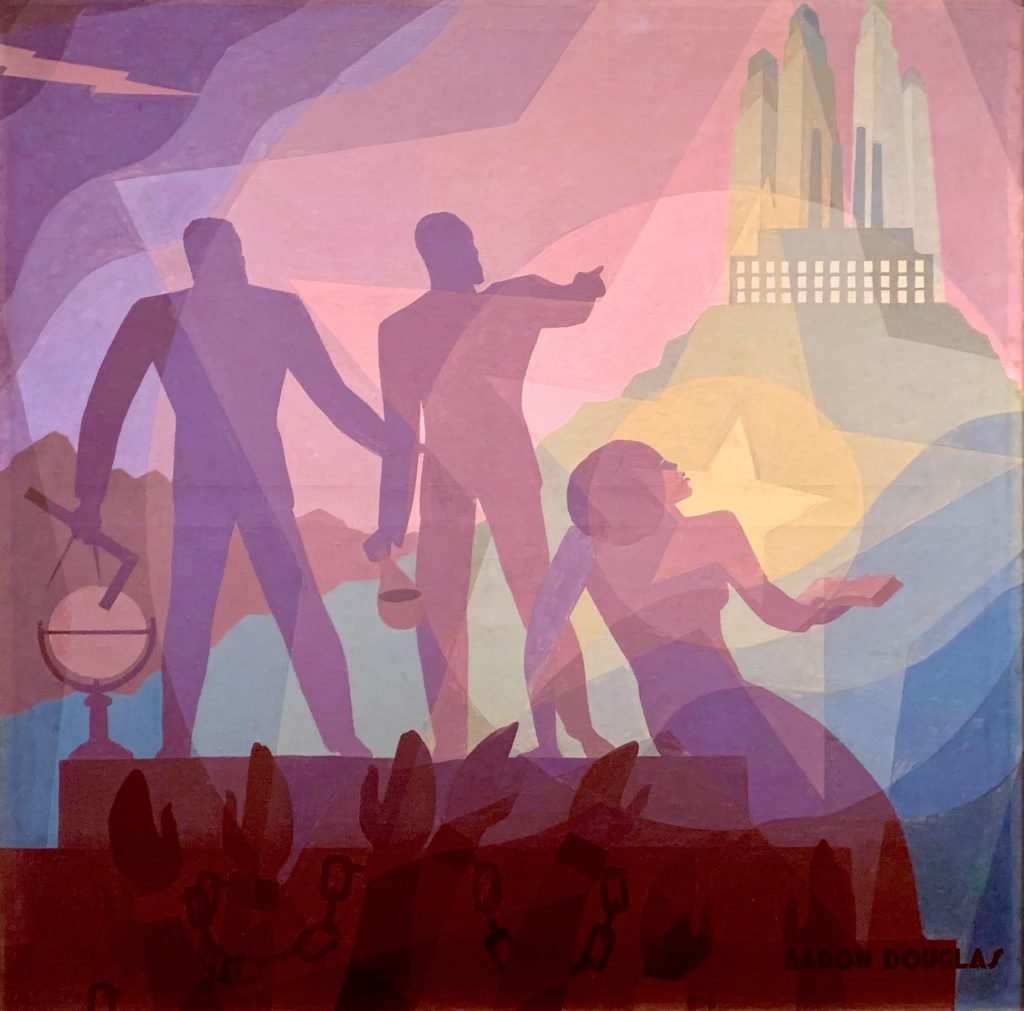
Is “The Harlem Renaissance and Transatlantic Modernism” at the Met a good show? Oh my, yes. The exhibition, curated by Denise Murrell, deserves every bit of acclaim that it is going to get. It deserves all the flowers.
“Harlem Renaissance” is a term most people will know, even if it has not always gotten its due in art textbooks (I talked with scholar Bridget Cooks about the history of the movement and its reception in last week’s Art Angle podcast). In some ways, it is still better known as a literary movement, a fact the show itself tacitly concedes in that it opens with portraits of a trio of literary figures: Langston Hughes, Zora Neale Hurston, and James Weldon Johnson. But if you want images that help make the case for the Harlem Renaissance’s importance as a movement in the visual arts, this show’s got ‘em.
Among the 160 works on view, the gallery of paintings by Aaron Douglas stands out as a highlight—fantastic icons of the era, with their dynamic geometry and modern silhouettes striding against fields of lavenders and ochres. Described by art historian Richard J. Powell as “Afro-Deco” in the catalogue, Douglas’s works conjugate Biblical narrative with Black history and the visions of an optimistic industrial future characteristic of Machine Age modernism.
So many other potential tentpole images stand out, from Jacob Lawrence’s classic 1942 image of a lively pool hall, the first work by Lawrence to be acquired by the Met, to the maquette for Meta Vaux Warrick Fuller’s Ethiopia Awakening (1921), a regal female figure in a headdress gracefully freeing herself from the mummy wrappings that bind her legs. The latter was originally commissioned by W.E.B. Du Bois and is today considered “the first Pan-African American work of art.”
But because Murrell’s sweeping exhibition offers such a broad survey of such under-appreciated history, I thought I would focus on a few of the more unexpected pieces.
Sargent Claude Johnson
Mask (1934)

Sargent Claude Johnson, Mask (1934) in “The Harlem Renaissance and Transatlantic Modernism.” Photo by Ben Davis.
Sargent Johnson’s elegant and ingenious mask is great on its own. It also makes a point for me.
In a sense, the banner term the “Harlem Renaissance” is misdirection when it comes to what is being surveyed in this show. The preferred term of the era would be the “New Negro Movement,” a more sociological and less geographically discrete phrase conveying the sense of urbanity and self-assertion of the emerging Black middle class in the ‘20s, propagandized by the philosopher Alain Locke. When it comes to visual arts production, Harlem was just one geographic character in the era’s foment. Archibald Motley was Chicago-based, for instance, while Laura Wheeler Waring labored in Philadelphia. One delightful find in this show is Bert Hurley’s Loose Nuts: A Rapsody in Brown, from 1933, a comic proto-comicbook account of goings on in the Black West End of Louisville, Kentucky.
As for Sargent Johnson, he was born in Boston to a mixed-raced family and orphaned at an early age before making his career all the way on the other coast, in the Bay Area. Yet works like this one, from a series of such mask sculptures, respond almost programmatically to Locke’s vision of a new cosmopolitan art, fusing ancestral African influences and modern aesthetics. Johnson’s copper-and-enamel sculpture is an invented ceremonial object, likely inspired by Baule masks from the Ivory Coast (though the keyhole eyes, I believe, are Johnson’s own inspiration).
Palmer Hayden
Fétiche et Fleurs (1932-33)
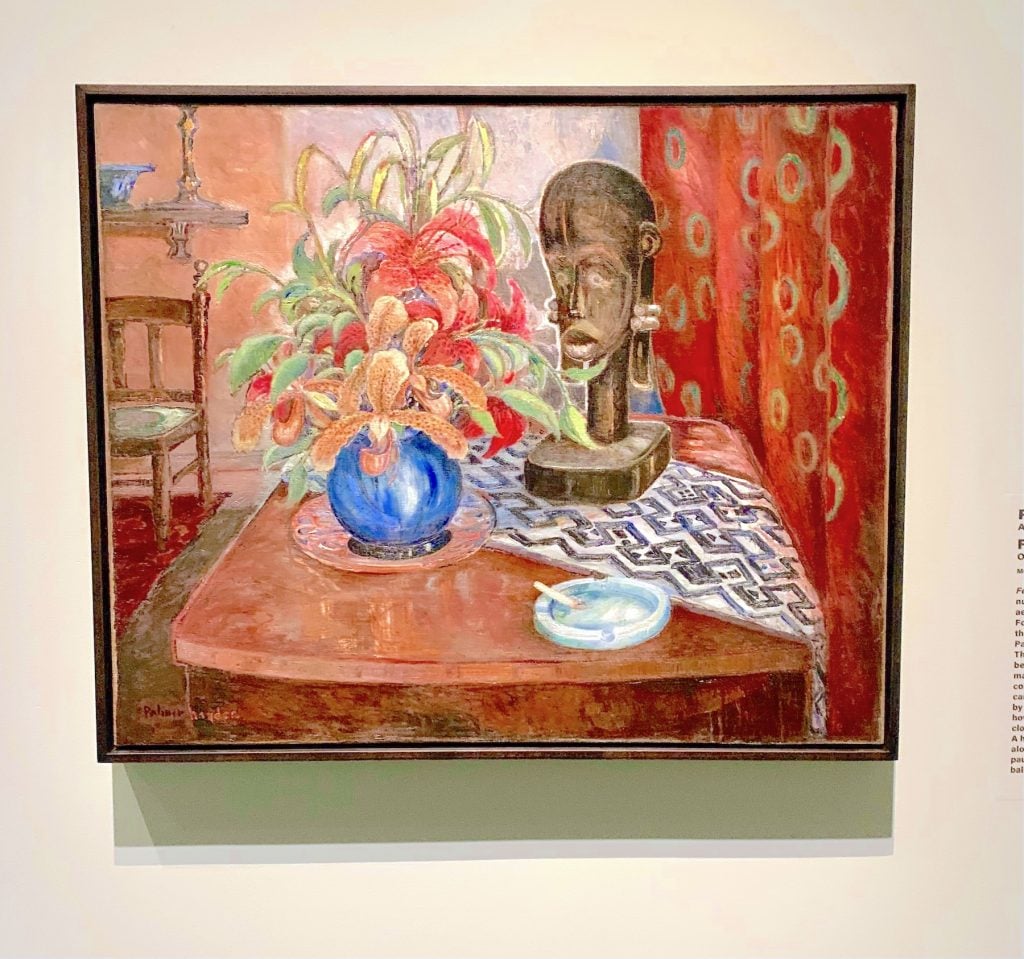
Palmer Hayden, Fétiche et Fleurs (1932–33). Photo by Ben Davis.
A number of artists here, even ones that would be associated with Harlem later, did their formative work outside the U.S., finding more room to self-define in Europe. Hayden was among them. This still life of flowers set alongside a carved Fang reliquary of the kind so popular with Cubists and Surrealists was shown, to acclaim, just after Hayden returned from Paris to the States in ’33.
Today, any discussion of the European avant-garde’s interest in African art must touch on issues of exoticism and cultural theft. Yet, in a way that is hard to see now, acclaimed “modern” artists taking inspiration from African art also opened a path to consider African heritage outside of its dominant association with cultural backwardness.
“There would be little hope of an influence of African art upon the western African descendants if there were not at present a growing influence of African art upon European art in general,” Alain Locke wrote in “The Legacy of the Ancestral Arts,” the most famous essay from his 1925 collection The New Negro. “But led by these tendencies, there is the possibility that the sensitive artistic mind of the American Negro, stimulated by a cultural pride and interest, will receive from African art a profound and galvanizing influence.”
Fétiche et Fleurs features a lit cigarette in an ashtray at the front of the table as if the artist is standing back and contemplating what the insertion of this African object into this genre of domestic painting means. More than any other artist here, Hayden sometimes has a difficult, hard-to-read way of including imagery that verges on racial stereotype into his canvases. Sometimes (as in We Four in Paris, from around 1930, or his once-controversial The Janitor Who Paints, from 1937, both also on view) it almost feels as if Hayden is deliberately challenging the viewer, painting his own self-conscious awareness of the ways that Black artists are seen. Because Fétiche et Fleurs translates to “Fetish and Flowers,” I do wonder if this painting isn’t on some level pondering what it means to fetishize African culture, as well.
William H. Johnson
Triple Self-Portrait (1944)
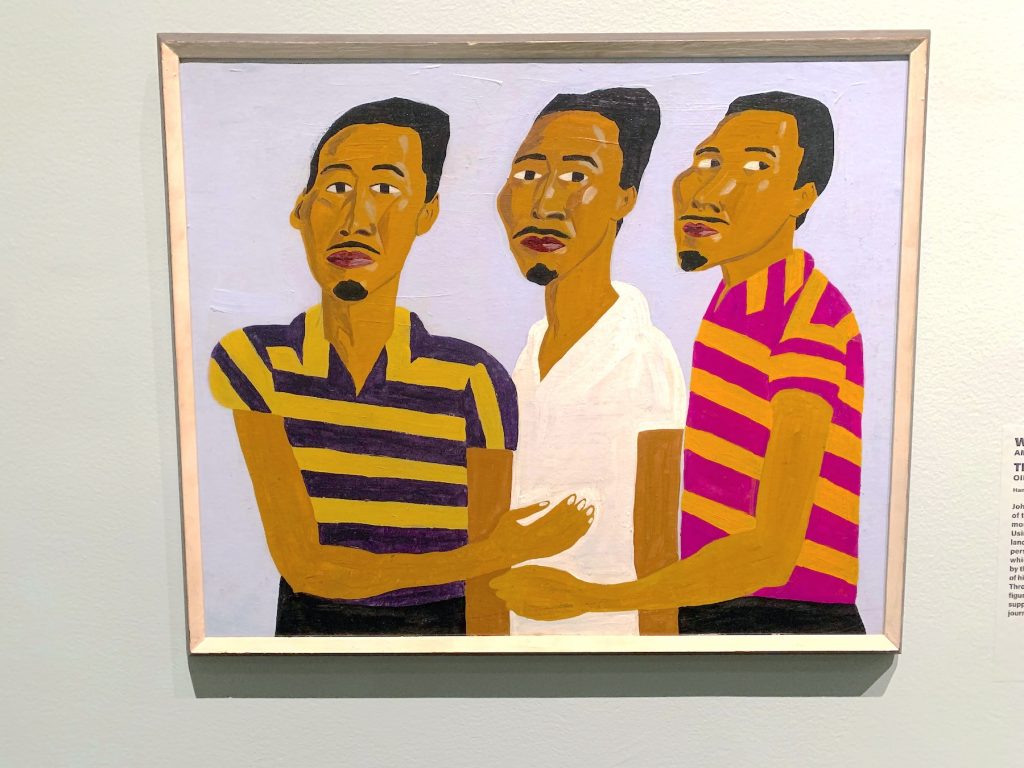
William H. Johnson, Triple Self-portrait (1944). Photo by Ben Davis.
Like Hayden, the North Carolina-born Johnson spent the 1920s—the high tide of the Harlem Renaissance, which is generally agreed to have ended with the Great Depression—in France, then most of the 1930s in Scandinavia after he married a Danish artist, Holcha Krake. When Johnson returned to the States in 1938, he was working in a deliberately direct, folk-art style.
In 1944, in the emotional turmoil after his wife died of breast cancer, and shortly before he went to the mental hospital where he spent the last decades of his life, he painted this enigmatic triple self-portrait. A white-clad self is at the center, flanked by two doppelgängers in differently colored striped shirts. One of the flanking selves meets your gaze, echoing the central figure; the other looks away. The expressions are uniform and unreadable, really those of someone deep in their own thoughts.
The duplicated self-portrait suggests, perhaps, a struggle to keep it together. The quiet surrealism of Triple Self-Portrait is like nothing else in this show, and very powerful to me.
Incidentally, despite his accomplishments, when he died in 1970, Johnson’s entire corpus was “almost disposed of to save storage fees,” the Smithsonian notes, “but it was rescued by friends at the last moment.”
Laura Wheeling Waring
Mother and Daughter (1927)
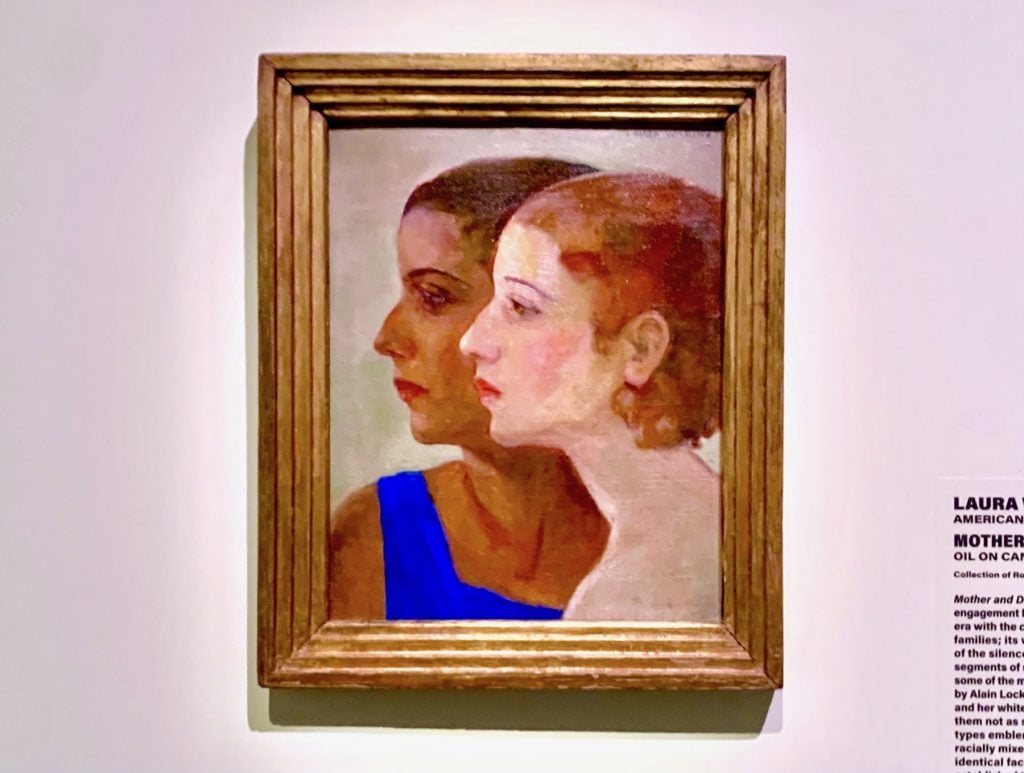
Laura Wheeler Waring, Mother and Daughter (1927). Photo by Ben Davis.
Small examples of sculptures by the influential Meta Vaux Warrick Fuller and Augusta Savage make an impact throughout. Still, as a whole, this show does suggest that the world of the Harlem Renaissance was very much male-dominated. One of the great stars the exhibition enters into the record, however, is Laura Wheeler Waring, celebrated in her time as one of the major painters of the “New Negro” era.
Waring was versatile. Perhaps my favorite images by her are her graphics for the covers of W.E.B. Du Bois’s magazine The Crisis, stylish Art Deco silhouettes that play on a mythology of Black Egypt. She also has illustrations from an unpublished children’s book here, Judy’s Story, as well as a variety of wildly elegant portraits of Black women in a dashing style that draws comparisons to John Singer Sargent.
One of the key images that will be remembered from this show is almost certainly Mother and Daughter (1927). In twinned profile, Waring captures two women, comparing their profiles and contrasting their skin tones and hair. As Murrell writes in the catalogue, the painting is “the most direct engagement by a prominent Black artist of that era with the controversial topic of racially mixed families; its very existence… was a disruption of the socially sanctioned silence on the subject within the Black upper classes.”
Archibald J. Motley, Jr.
Cocktails (ca. 1926)

Archibald J. Motley, Jr., Cocktails (ca. 1926). Photo by Ben Davis.
Here is an image from the Harlem Renaissance at high noon, from 1926—albeit one from Chicago, not Manhattan. Motley’s riotous, colorful images of street life, picnics, and dancehalls—and a witty, dapper self-portrait—go off like fireworks throughout this show. (Many of the works here were also in the Whitney’s memorable 2015 survey, “Archibald Motley: Jazz Age Modernist.“)
A desire for respectability threaded through a lot of the discourse around the Harlem Renaissance, with its hunger for images of stylish achievement. The movement was fired by an embattled middle class’s desire to throw off the burden of stereotype in a white-dominated world. But the imperative to make positive images, too, could be a straitjacket.
“If white people are pleased we are glad. If they are not, it doesn’t matter. We know we are beautiful. And ugly too…” Langston Hughes wrote in 1926 in “The Negro Artist and the Racial Mountain,” one of the most famous manifestos of the period. “If colored people are pleased we are glad. If they are not, their displeasure doesn’t matter either.”
Cocktails nicely represents this freedom to survey complex experiences in a way that art aimed at a white audience could not. A group of smartly clad ladies enjoy a boozy afternoon—apparently on an empty stomach, as the butler is just bringing in a chicken, at left. The posture of the laughing woman in the white dress at left is slouchy; you can the gathering is a few drinks in. At the far left, another woman has already passed out on the couch.
Everyone notices the deliberately contrasting painting-within-the-painting of a group of monks on the wall above them, suggesting Motley is looking at the difference between middle-class pieties and real conduct, with an affectionately ironic eye. (This painting hails from deep within Prohibition.) More subtle is the inclusion of another painting, above the mantle, a shoulder-length portrait of a woman whose head is cut off by the hanging lamp in Motley’s composition. I think it hints that the guests at this cocktail party are letting themselves cut loose from expected images of respectability.
Aaron Douglas
Scottsboro Boys (1935)
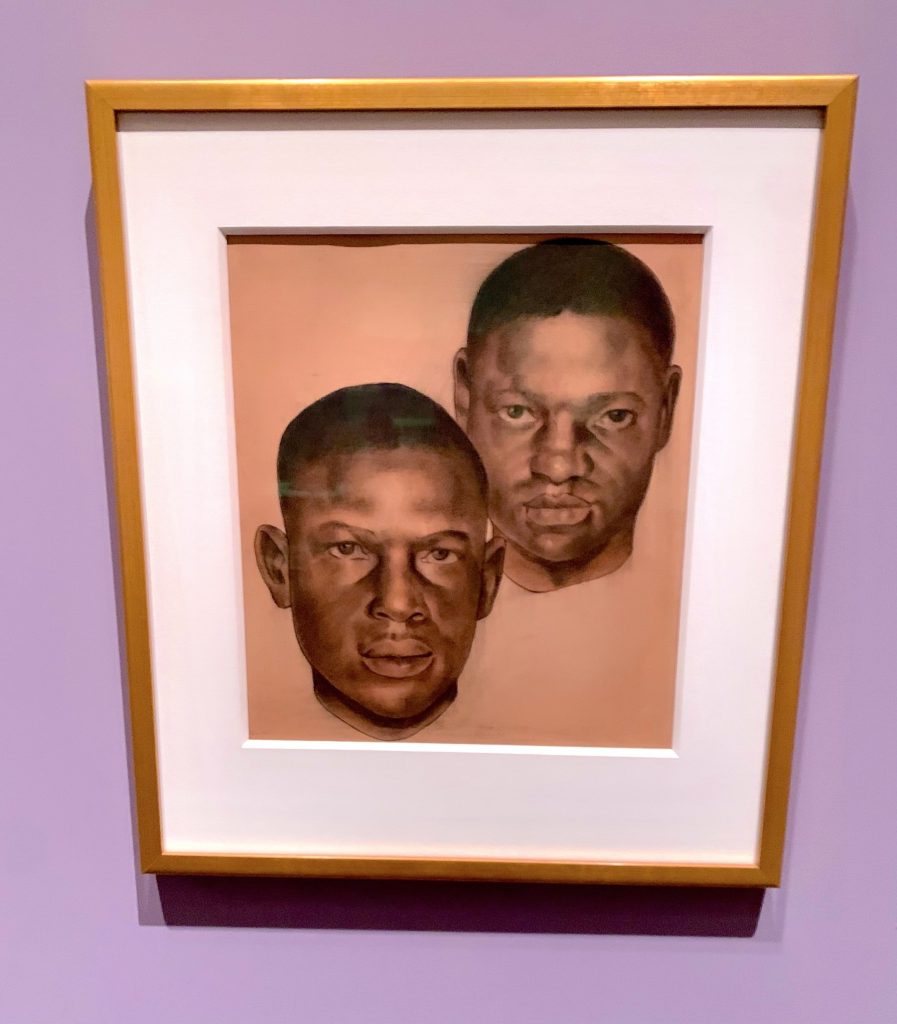
Aaron Douglas, Scottsboro Boys (1935). Photo by Ben Davis.
The show ends with a gallery dedicated to protest. Probably the most impactful inclusion is this sober pastel of Clarence Norris and Haywood Patterson, two of the defendants in the infamous Scottsboro Boys case, which galvanized a nationwide movement around the plight of nine Black teenagers sentenced to death in Alabama on trumped-up rape charges.
In the 1930s, Douglas joined the Communist Party, which had represented the Scottsboro Boys through its International Labor Defense arm, pioneering a protest-oriented, put-the-system-on-trial style of legal campaign that placed it at odds with the more cautious NAACP. Harlem was the site of huge protests in solidarity with the Scottsboro Boys throughout the early 1930s, and their case became an international symbol of the evils of Jim Crow. Many Black intellectuals found the CP’s militant style a vital draw. Douglas’s Scottsboro Boys dates from 1935, when the Supreme Court overturned the convictions of his two subjects in Patterson v. Alabama and Norris v. Alabama, based on the argument that excluding Black people from juries violated the “equal protection” clause.
In an essay on Douglas, Susan Earle mentions that his isolation of the boys’ heads in this image might evoke the prospect of “heads rolling,” given the death sentence they had faced. It also evinces the influence of Douglas’s mentor, the German-born artist Winold Reiss, who did many portraits of Harlem notables for Alain Locke (some on view elsewhere in this show) characterized by setting areas of fine detail off against patches of radical simplification (check out his portrait of W.E.B. Du Bois, below).
Still, Douglas’s political graphic is very different from the energetic geometric style that he was perfecting at the same time in his famous Aspects of Negro Life murals for Harlem’s Schomburg Center. I’ve seen it suggested that the Scottsboro Boys drew from a Communist Party pamphlet about the case. I wonder if its directness doesn’t reflect the CP’s preference for the directness of social realism in the early ’30s, as well.
See more images from “The Harlem Renaissance and Transatlantic Modernism,” below.
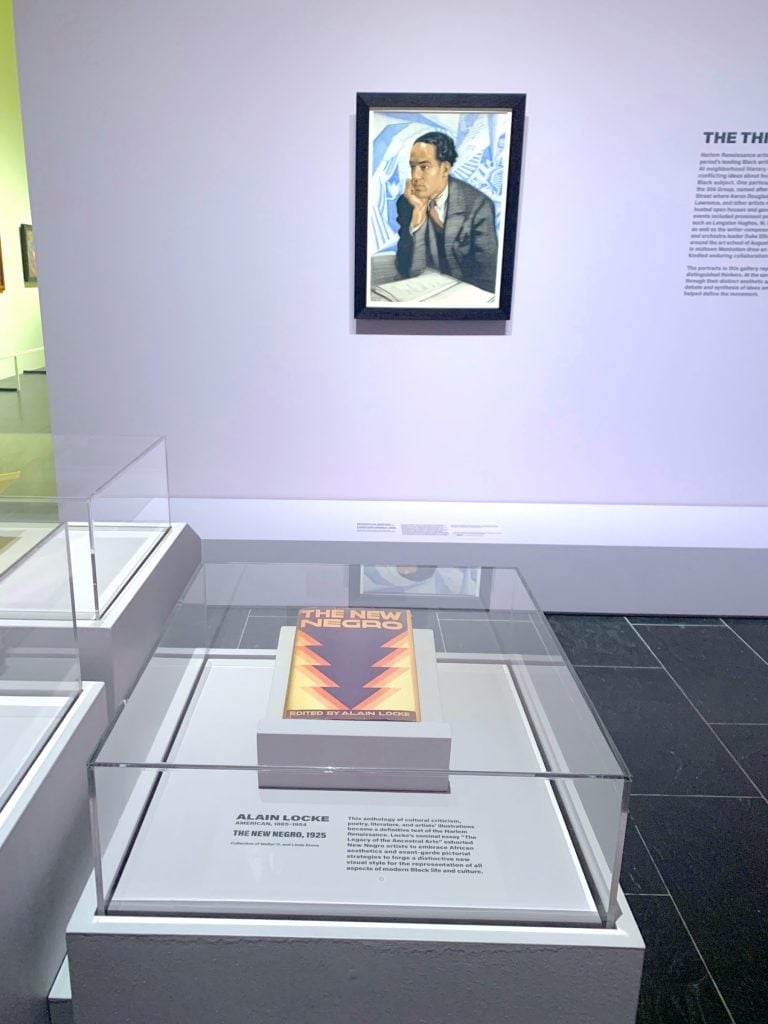
Winold Reiss, Langston Hughes (ca. 1925) and a copy of Alain Locke’s The New Negro at the Metropolitan Museum of Art. Photo by Ben Davis.

Laura Wheeler Waring, James Weldon Johnson (1943) and Aaron Douglas, Miss Zora Neale Hurston (1926) in “The Harlem Renaissance and Transatlantic Modernism” at the Metropolitan Museum of Art. Photo by Ben Davis.
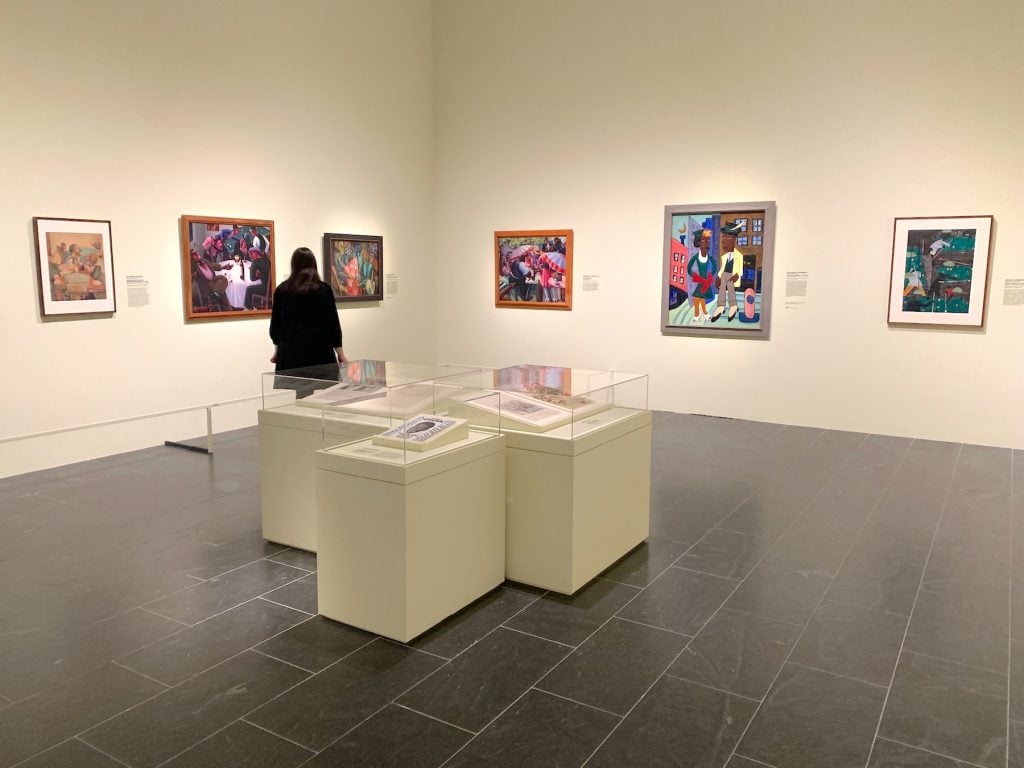
The “Everyday Life in New Black Cities” gallery of “The Harlem Renaissance and Transatlantic Modernism” at the Metropolitan Museum of Art. Photo by Ben Davis.
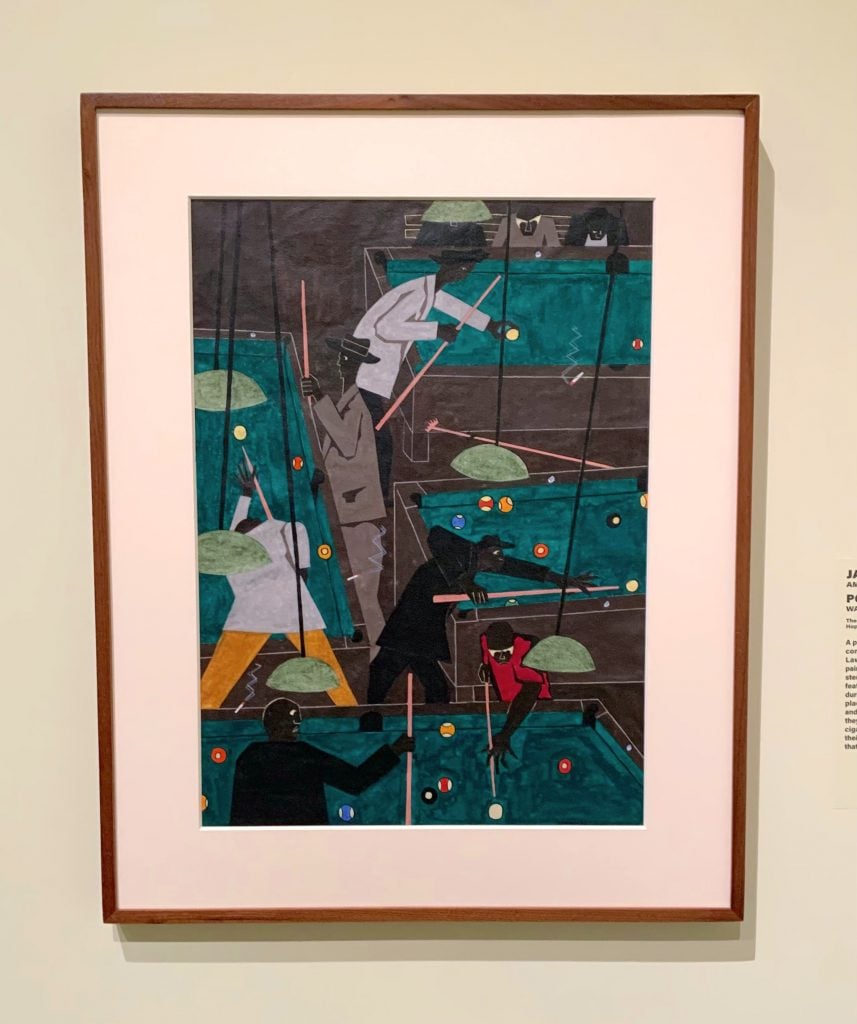
Jacob Lawrence, Pool Parlor (1942) at the Metropolitan Museum of Art. Photo by Ben Davis.
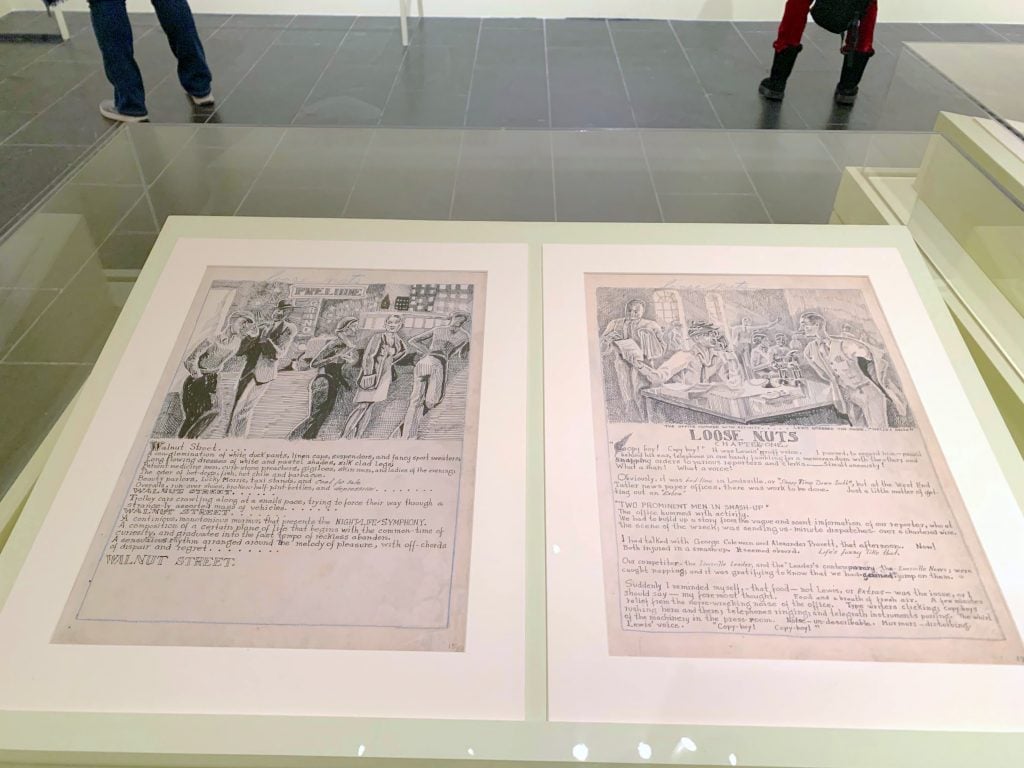
Bert Hurley, Pages from Loose Nuts: A Rapsody in Brown (1933) at the Metropolitan Museum of Art. Photo by Ben Davis.
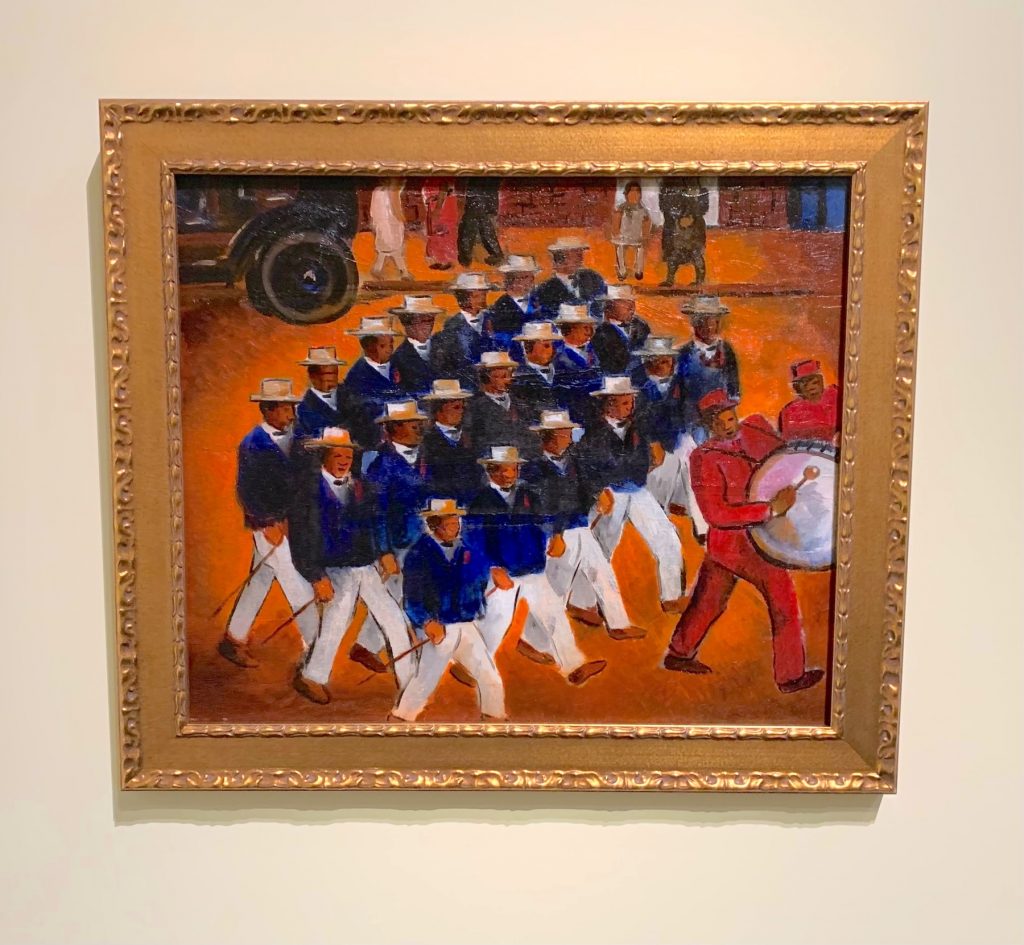
Malvin Gray Johnson, American, Elks Marching (1934) at the Metropolitan Museum of Art. Photo by Ben Davis.

Four paintings in the “Portraiture and the Modern Black Subject” gallery of “The Harlem Renaissance and Transatlantic Modernism” at the Metropolitan Museum of Art. Photo by Ben Davis.
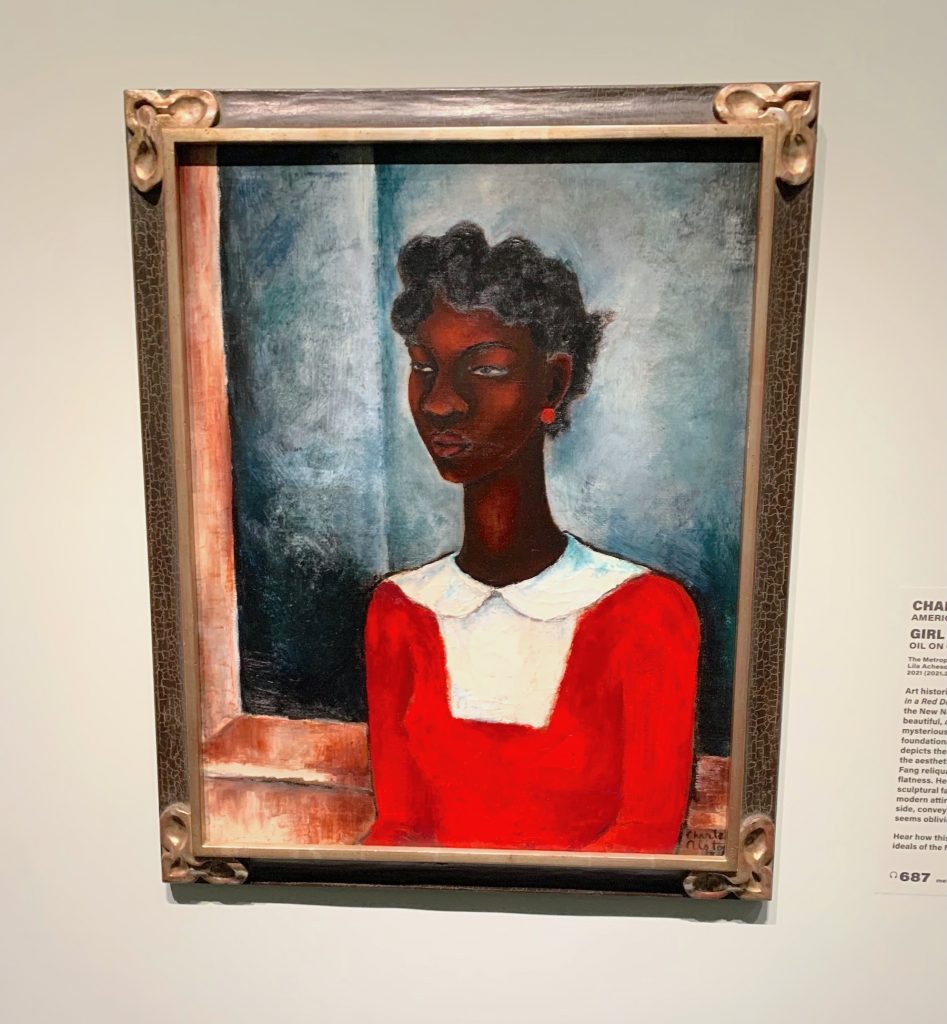
Charles Henry Alston, Girl in a Red Dress (1934) at the Metropolitan Museum of Art. Photo by Ben Davis.

William H. Johnson, Woman in Blue (ca. 1943) in the Metropolitan Museum of Art. Photo by Ben Davis.
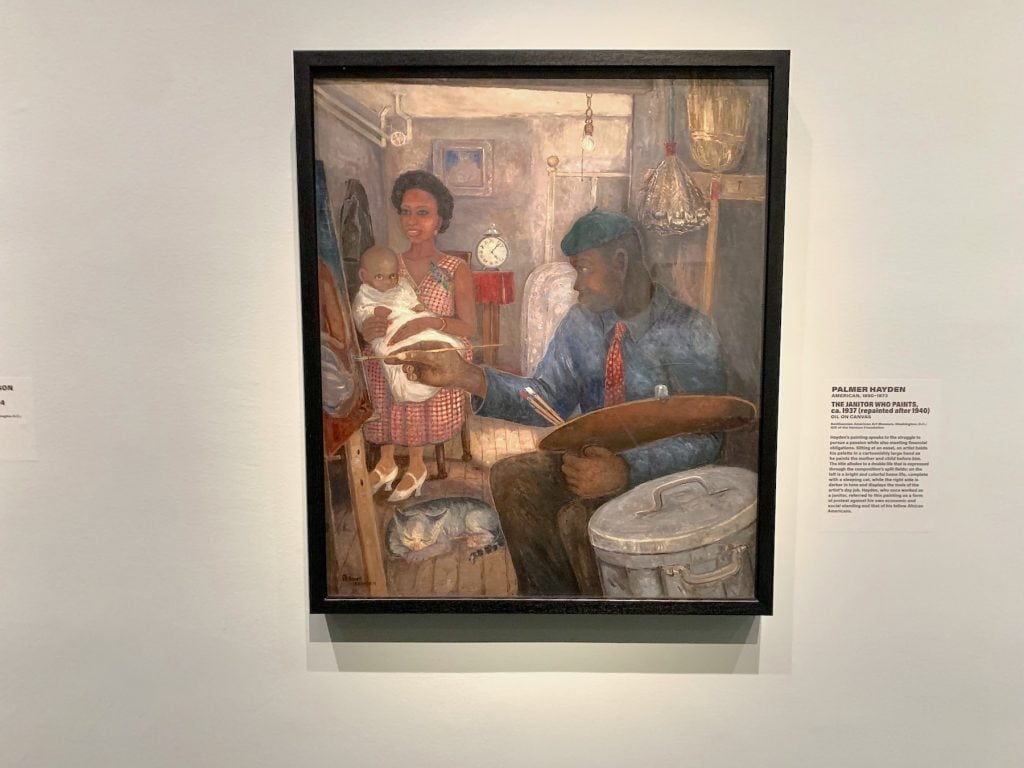
Palmer Hayden, The Janitor Who Paints (ca. 1937) in the Metropolitan Museum of Art. Photo by Ben Davis.
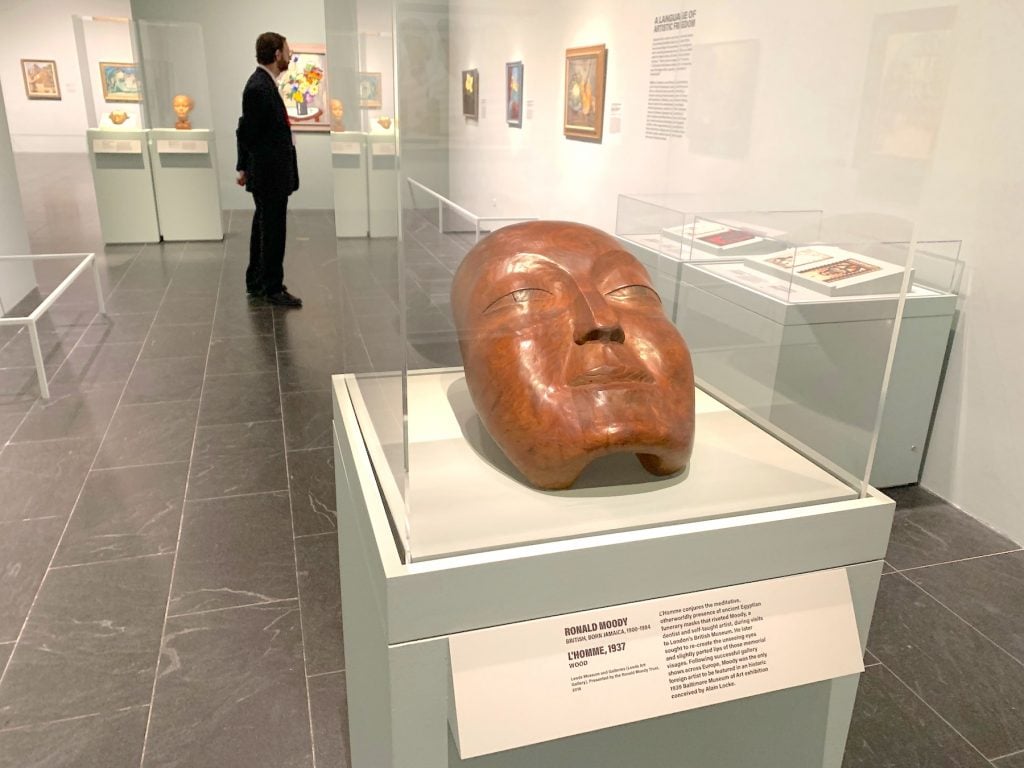
Ronald Moody, L’Homme (1937) at the Metropolitan Museum of Art. Photo by Ben Davis.

Laura Wheeler Waring, The Strength of Africa, cover of The Crisis (September 1924) and Aaron Douglas, cover of Fire!!! (November 1926). Photo by Ben Davis.
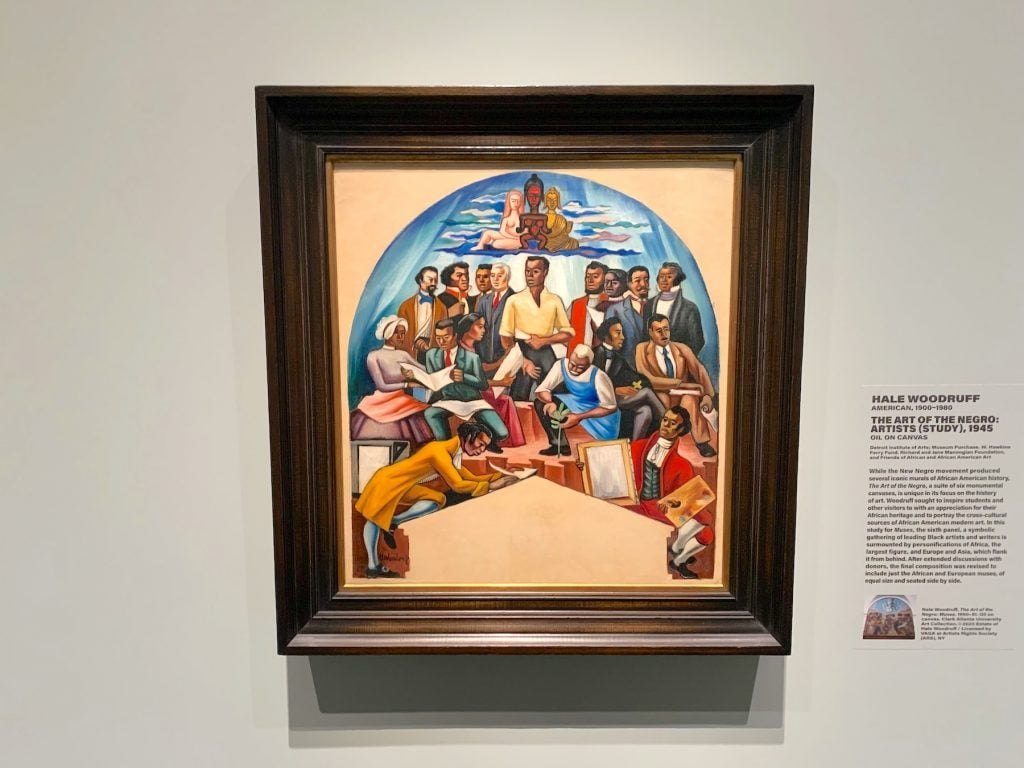
Hale Woodruff, The Art of the Negro (Study) (1945) at the Metropolitan Museum of Art. Photo by Ben Davis.
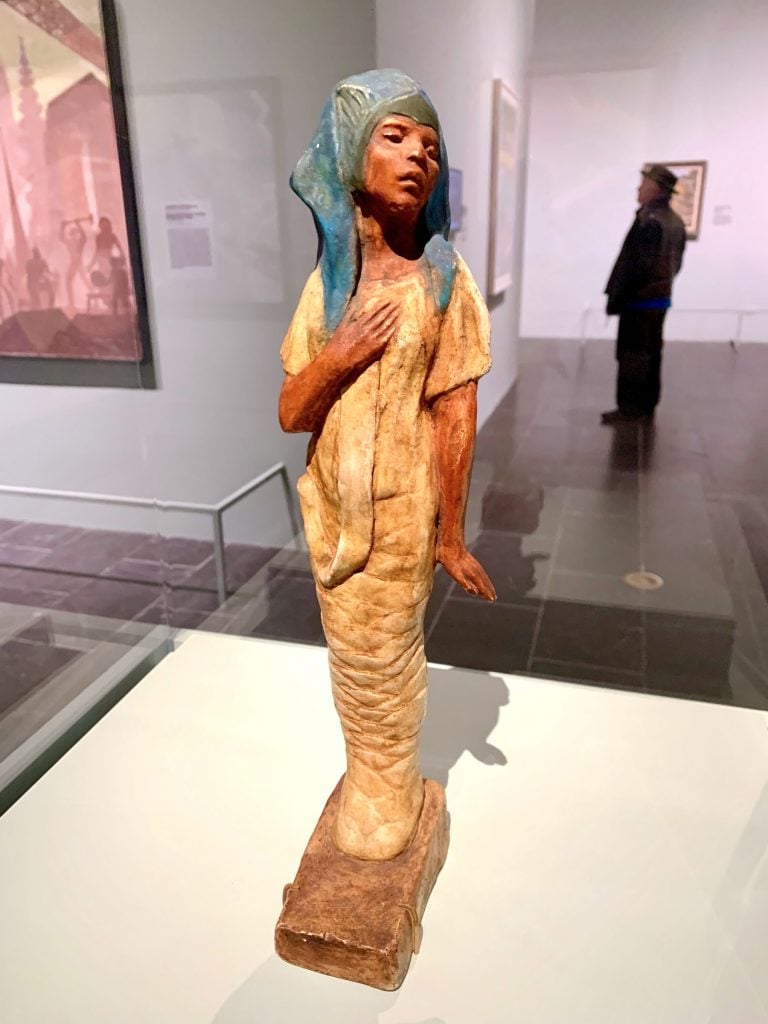
Meta Vaux Warrick Fuller, maquette for Ethiopia Awakening (1921). Photo by Ben Davis.
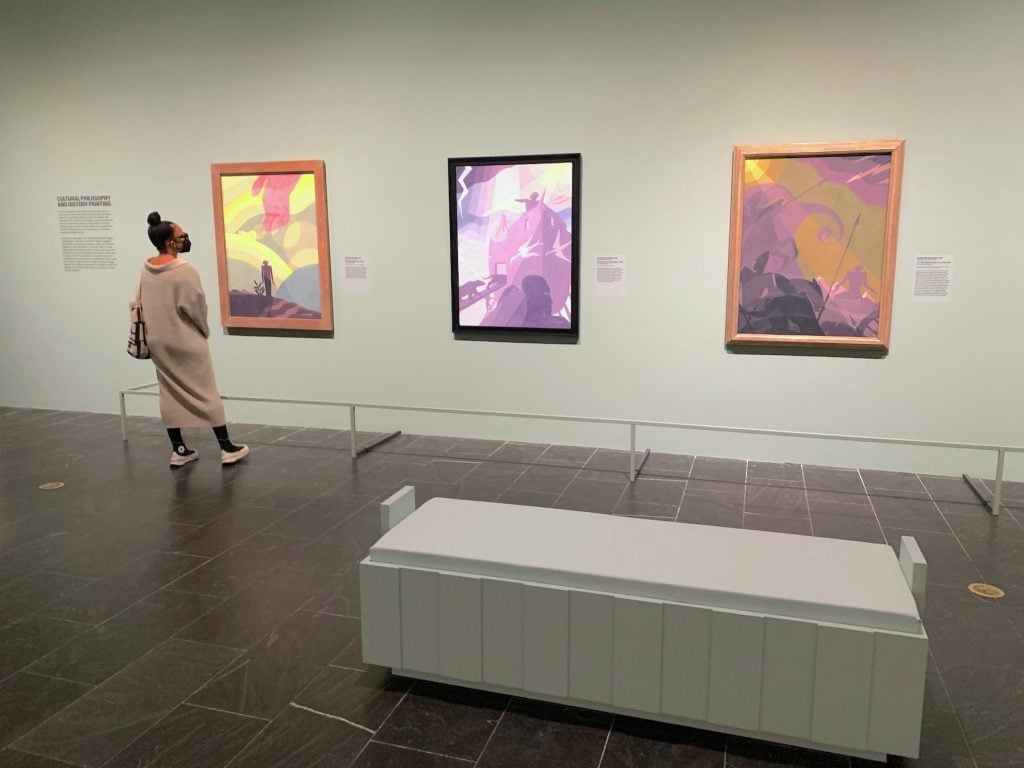
Paintings by Aaron Douglas in “The Harlem Renaissance and Transatlantic Modernism” at the Metropolitan Museum of Art. Photo by Ben Davis.

Aaron Douglas, Let My People Go (ca. 1935-39) and Aspects of Negro Life: From Slavery Through Reconstruction (1934) at the Metropolitan Museum of Art. Photo by Ben Davis.
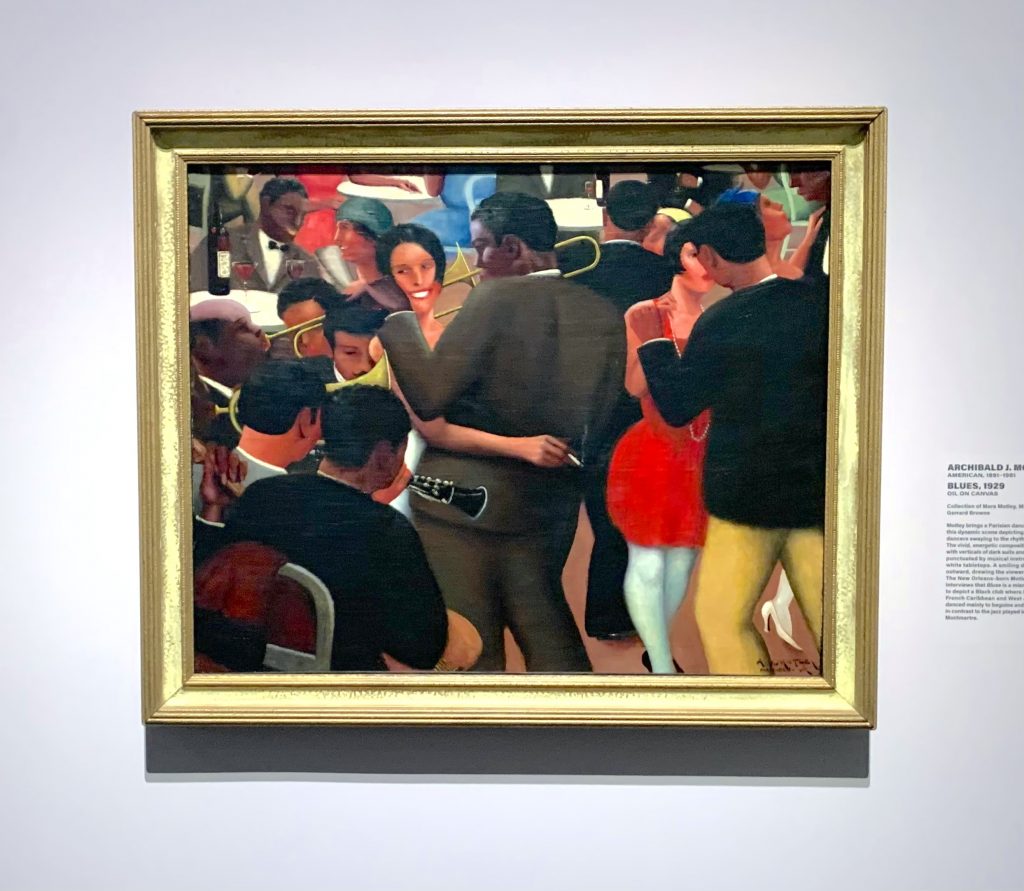
Archibald J. Motley, Jr., Blues (1929) at the Metropolitan Museum of Art. Photo by Ben Davis.
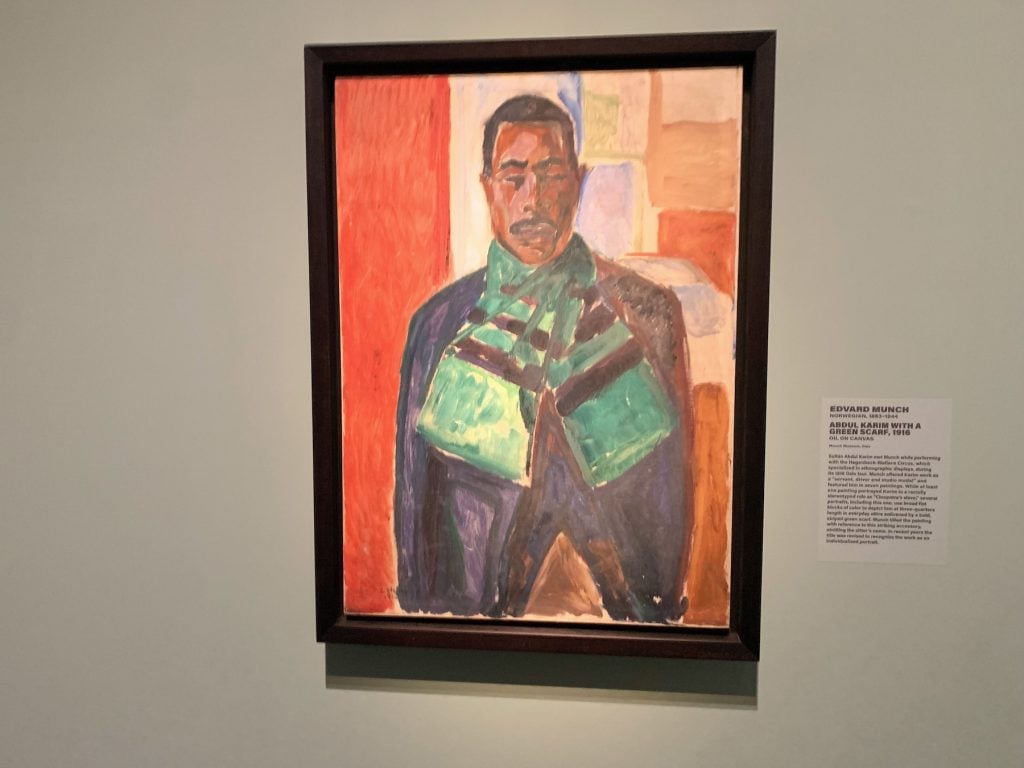
Edvard Munch, Abdul Karim with a Green Scarf (1916) at the Metropolitan Museum of Art. Photo by Ben Davis.
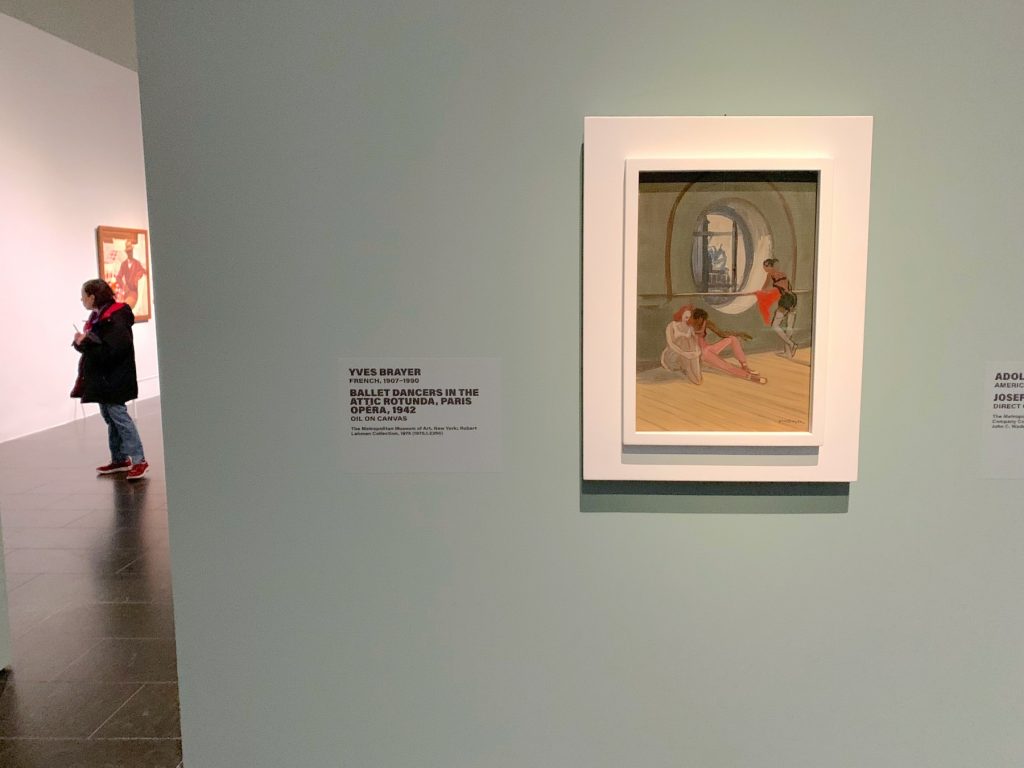
Yves Breyer, Ballet Dancers in the Attic Rotunda, Paris Opera (1942) displayed at the Metropolitan Museum of Art. Photo by Ben Davis.
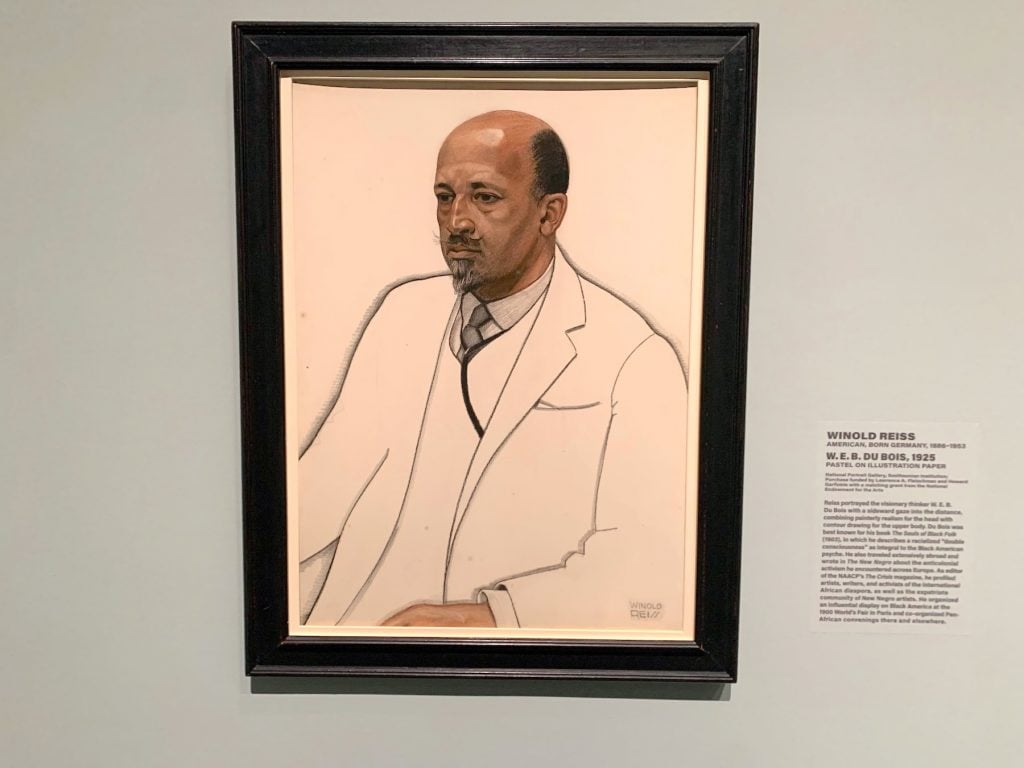
Winold Reiss, W.E.B. Du Bois (1935) in the Metropolitan M.seum of Art. Photo by Ben Davis;
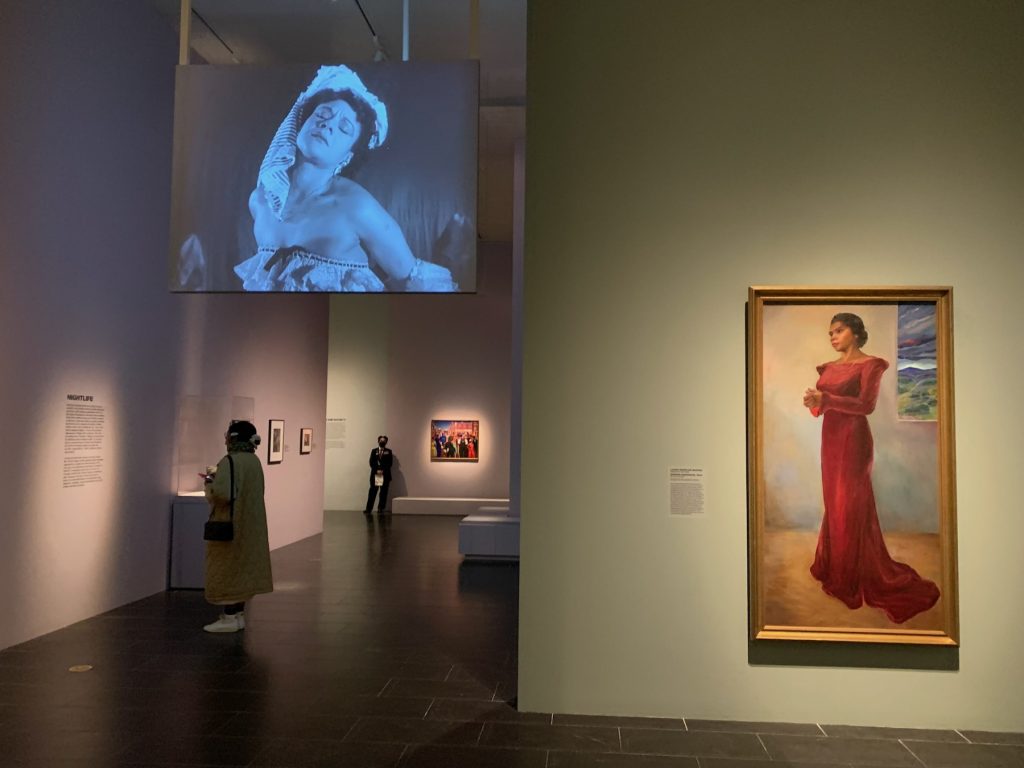
A screen showing a 1952 performance by Katherine Dunham and Laura Wheeler Waring, Marian Anderson (1944). Photo by Ben Davis.

Paintings in the “Nightlife” gallery of “The Harlem Renaissance and Transatlantic Modernism” at the Metropolitan Museum of Art. Photo by Ben Davis.
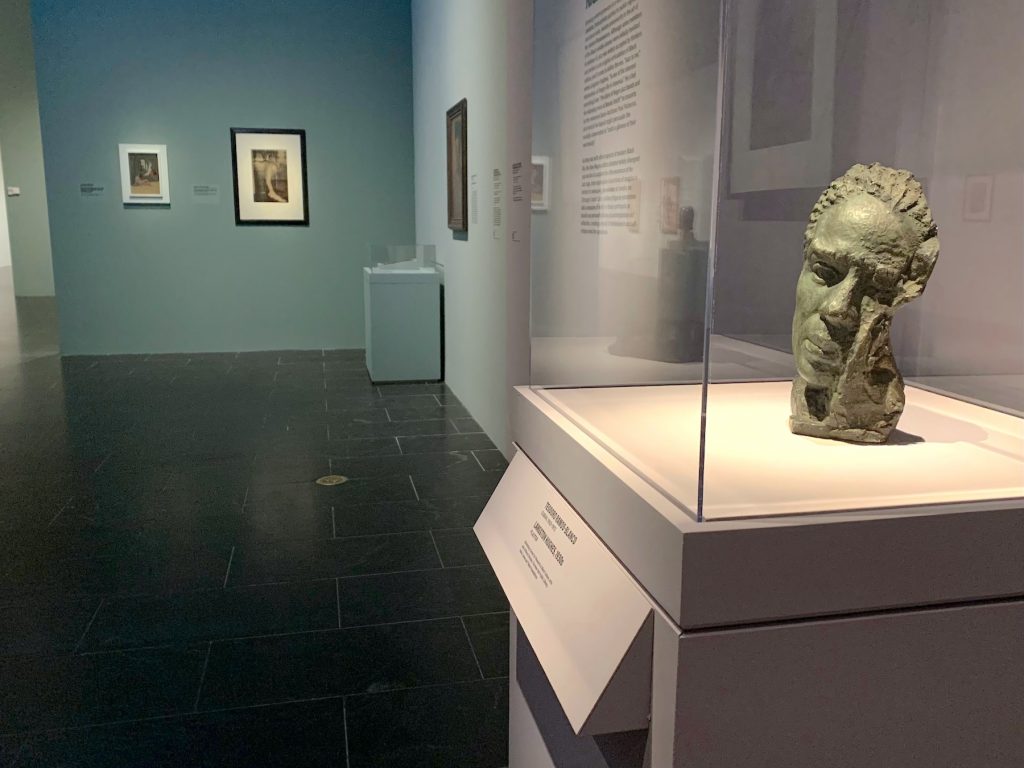
Teodoro Ramos-Blanco, Langston Hughes (1930s). Photo by Ben Davis.
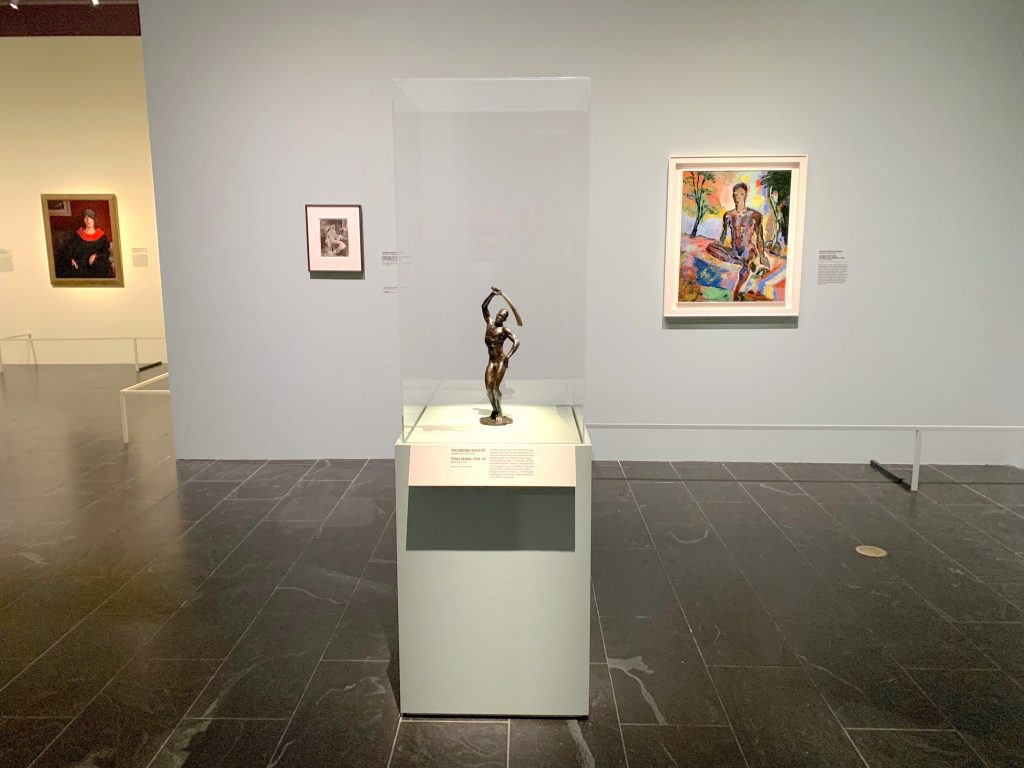
The “Family and Society” gallery in “The Harlem Renaissance and Transatlantic Modernism.” Photo by Ben Davis.
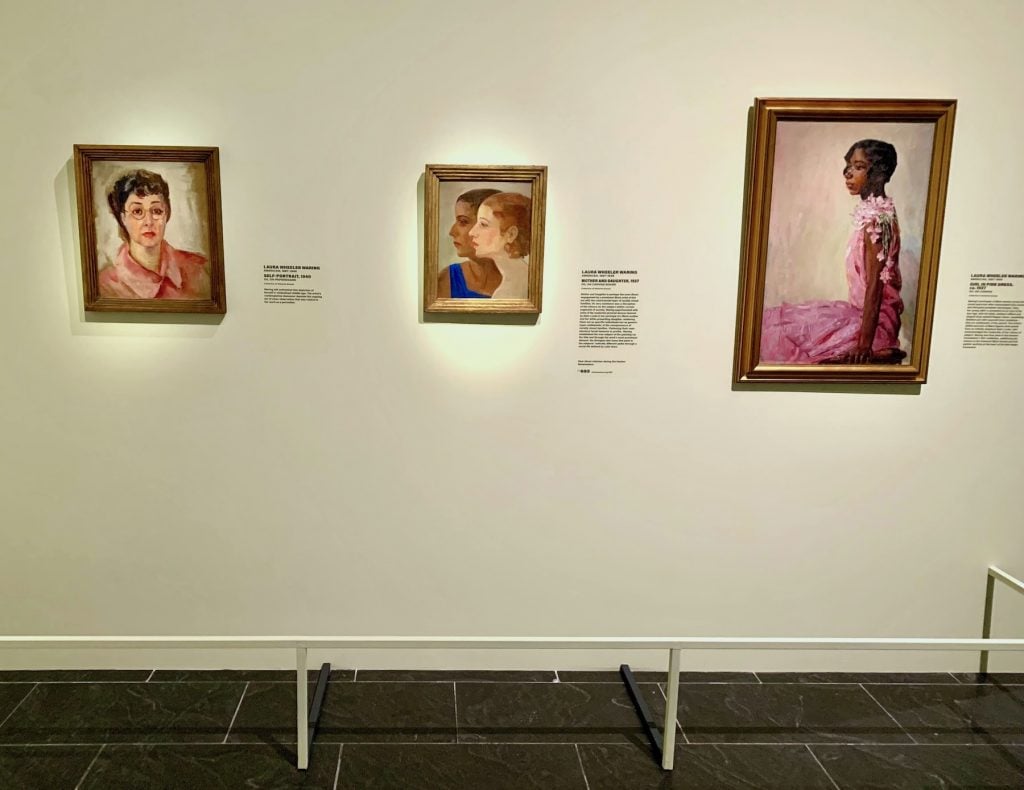
Three paintings by Laura Wheeler Waring. Photo by Ben Davis.
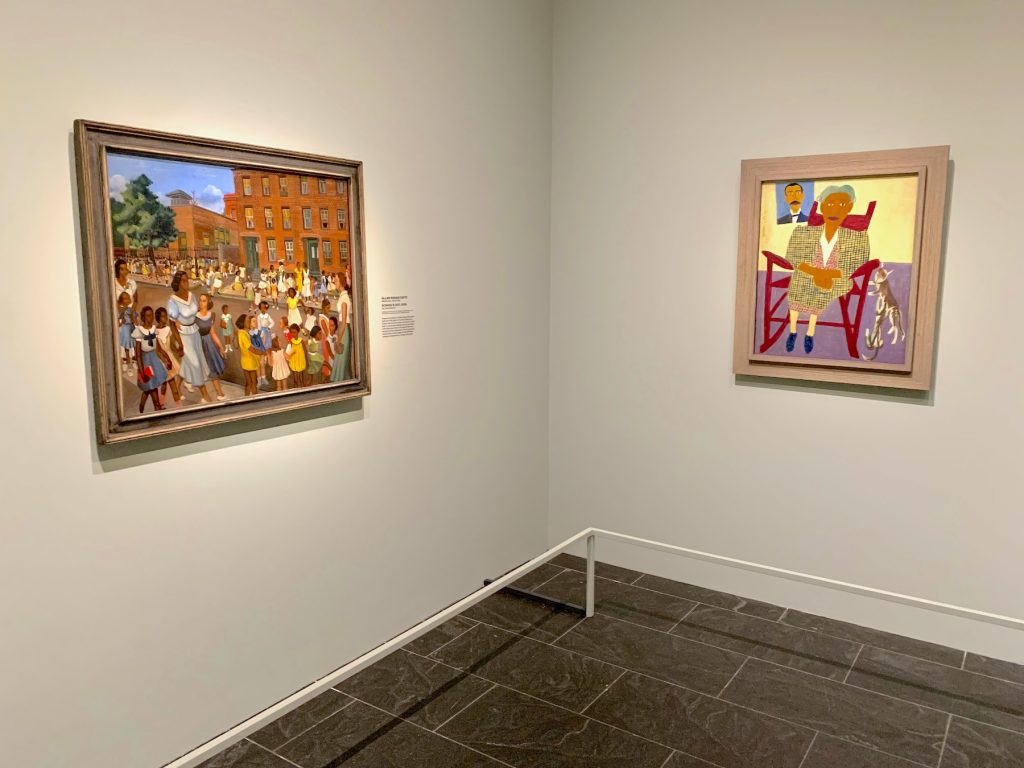
Allan Rohan Crite, School’s Out (1936) and William H. Johnson, Mom and Dad (1944) at the Metropolitan Museum of Art.
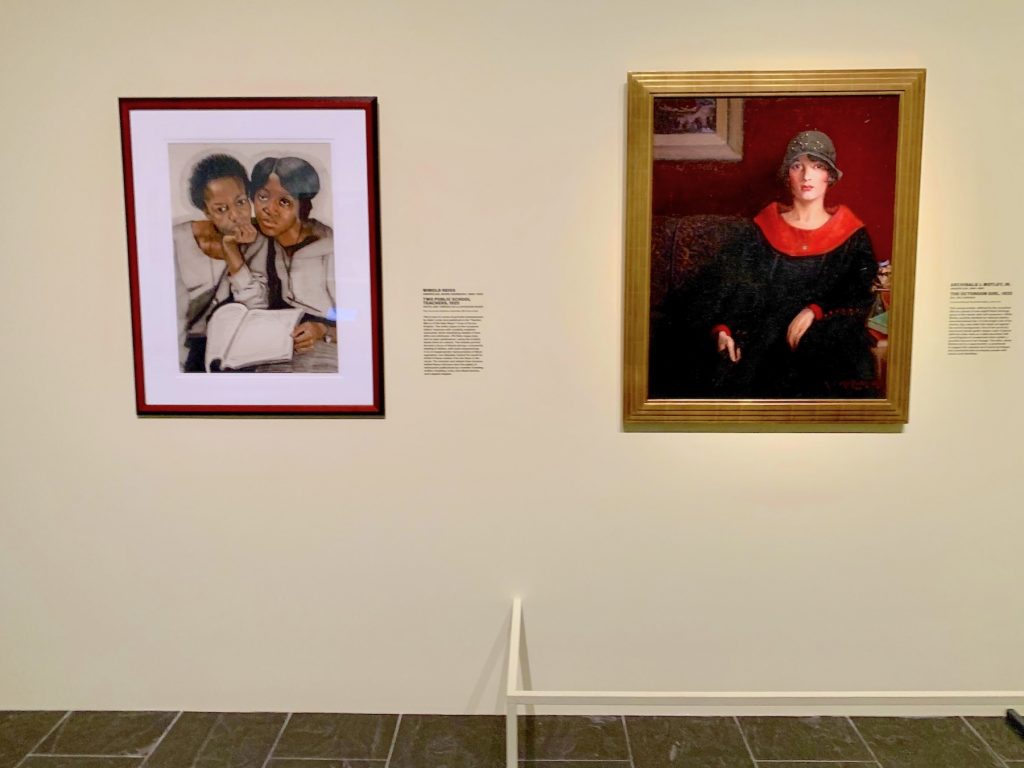
Winold Reiss, Two Public School Teachers (1925) and Archibald J. Motley, Jr., The Octoroon Girl (1925) at the Metropolitan Museum of Art. Photo by Ben Davis.
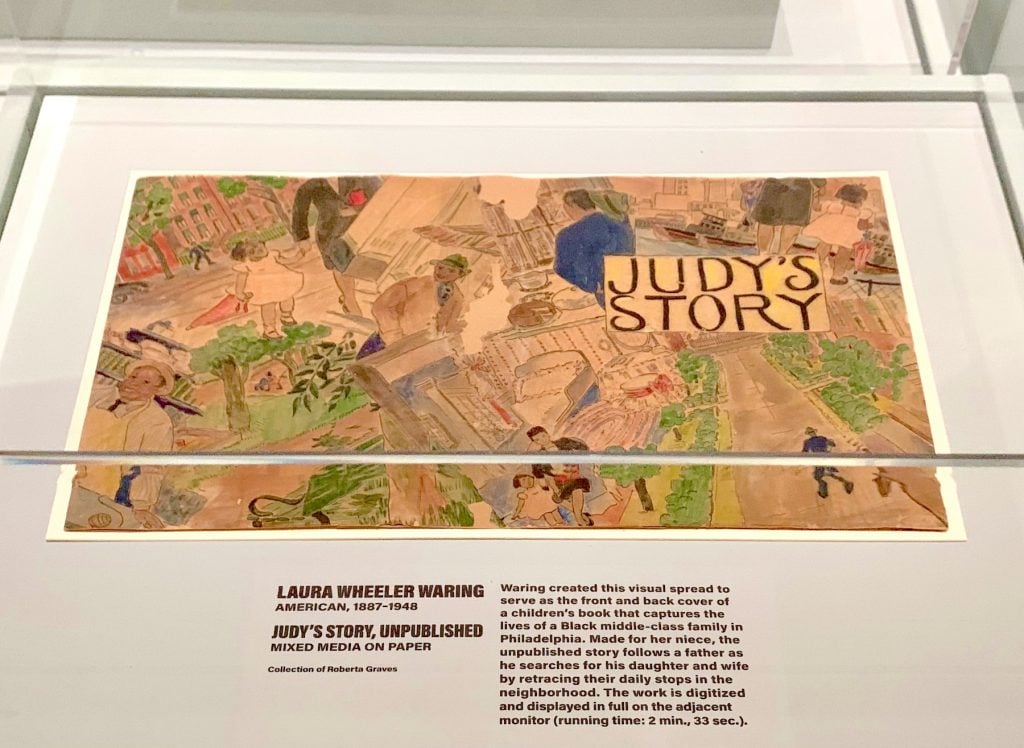
Laura Wheeler Waring’s unpublished Judy’s Story displayed at the Metropolitan Museum of Art. Photo by Ben Davis.
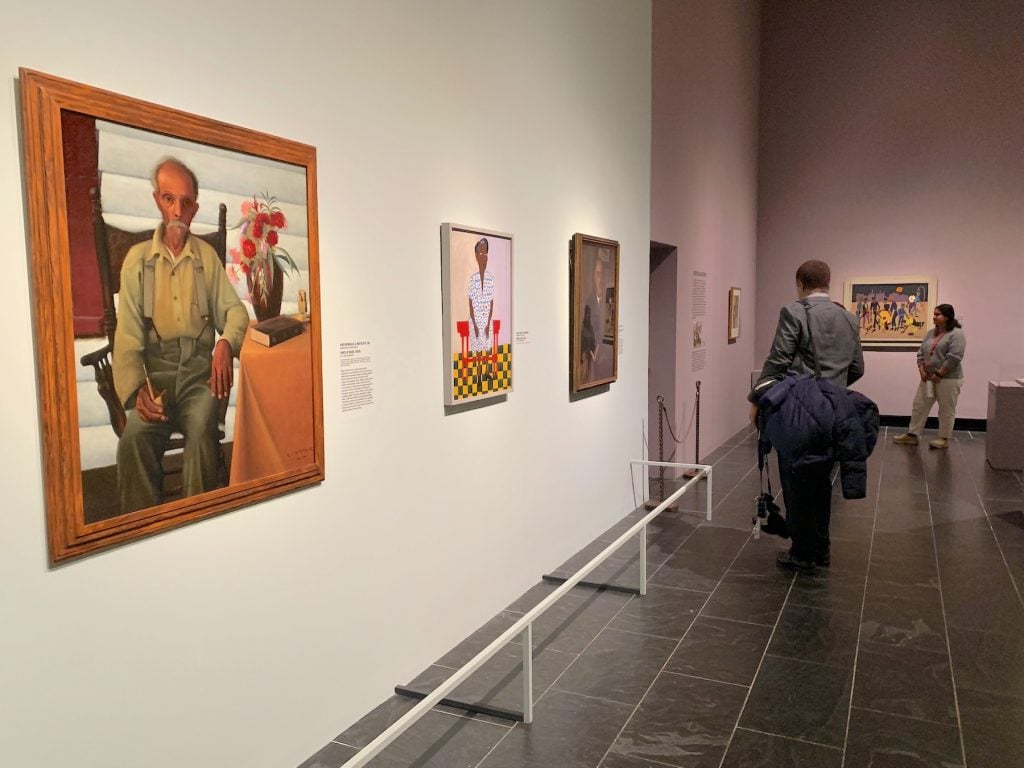
The “Family and Society” gallery in “The Harlem Renaissance and Transatlantic Modernism.” Photo by Ben Davis.
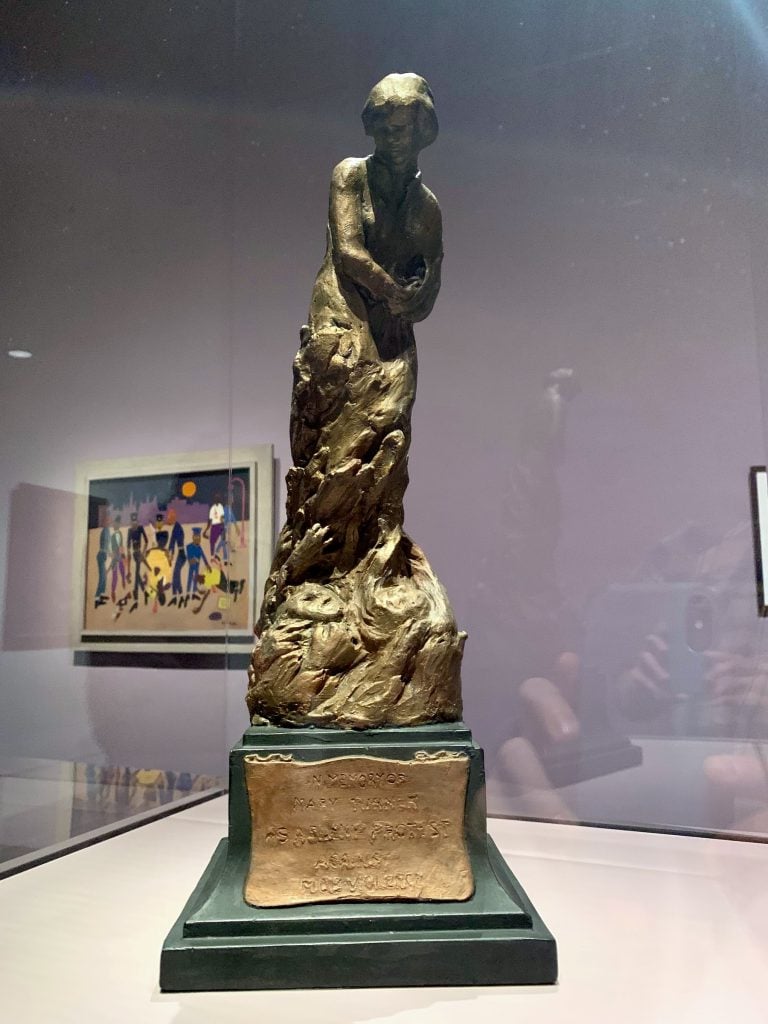
Meta Vaux Warrick Fuller American, In Memory of Mary Turner as a Silent Protest Against Mob Violence (1919) at the Metropolitan Museum of Art. Photo by Ben Davis.
“The Harlem Renaissance and Transatlantic Modernism” is on view at the Metropolitan Museum of Art, New York, through July 28, 2024.





